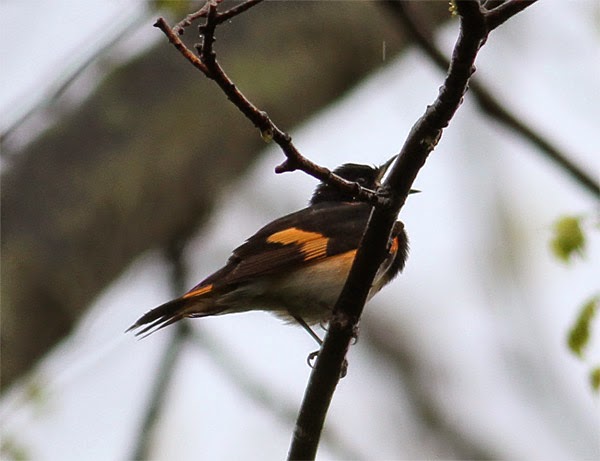 |
| Drake Scaup - Note shape of head and size and shape of black on tip of the bill |
 |
| American Black Tern |
 |
| American Black Tern |
 |
| American Black Tern |
It was still raining hard at this point, but with the sky appearing brighter behind the weather I made the decision to head for the point. My timing was perfect as no sooner had I got off the bus, the rain eased. The conditions were calmer than the previous day which made birding a more pleasurable experience, and immediately I was into the warblers. Tennessee was first followed by a Northern Parula, another Wilson’s, Common Yellowthroat and American Redstart.
 |
| Male American Redstart |
 |
| Red-eyed Vireo |
 |
| Philadelphia Vireo |
The weather had now cleared and so I decided to walk the trails back to where my car was at the visitor’s centre. Species wise the mix was much the same as at the tip but I did manage to see Swainson’s Thrush, Blackpoll Warbler and Red-bellied Woodpecker, which were all new for the trip.
With things quietening down at the point I decided to head to Hillman Marsh for some wetland birding, but thought I would make a quick stop at this trail before leaving. The trail passes through patches of scrub, poplar woodland and includes a boardwalk section. A White-throated Sparrow was feeding in the car park as I arrived and on the trail there were more American Redstarts, a pair of Common Yellowthroats, two Tennessee Warblers and a couple of Black and White Warblers.
 |
| Black and White Warbler |
 |
| Black and White Warbler |
Despite being one of the least colourful warblers these birds are real characters and one of my favourites. The black and white striping gives them a striking appearance and their habit of running up and down branches and trunks makes them appear more similar to the nuthatches than New World Warblers.
I had visited Hillman Marsh back on the 19th May, my first day in the area. I had arrived at around 3pm and the wetland was full of waders, but most things were very distance since the water levels were too high. The most common species was Black-bellied Plover, Grey in the UK, with the other wader species including Dunlin (100+), Turnstone (15+), Short-billed Dowitcher (5), Semi-palmated Plover (15), Killdeer (1), Least Sandpiper (1, that I could see) and two Stilt Sandpipers. The Stilt Sands were just coming into summer plumage and looked very smart. Several duck species were also present including Northern Shoveler, Mallard, Blue-winged Teal and Gadwall.
Today the waders were even more distant, so combined with the the haze caused by the afternoon sun, viewing was not good. Black-bellied Plovers were again the most numerous but there was also a flock of 159 Hudsonian Whimbrel. Other waders included over 100 Dunlin, five Least Sandpipers, three Turnstone and a Spotted Sandpiper. Around 200 gulls and terns were also present, mostly Ring-billed Gulls, but also Herring and Bonaparte’s, three Caspian Terns and 15 Forster’s Terns. As I headed back to the car I picked up a flock of 30 Cedar Waxwing feeding on some berries from a Viburnum species.
 |
| Cedar Waxwing |
No comments:
Post a Comment